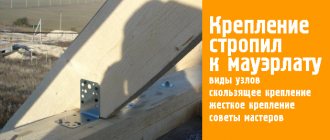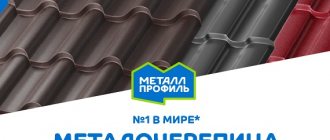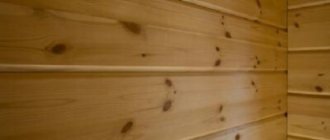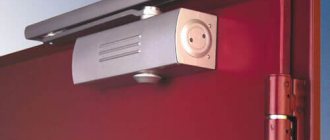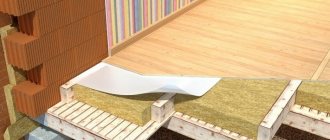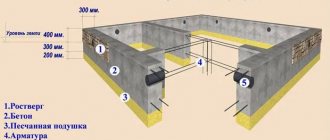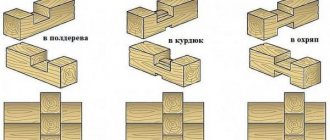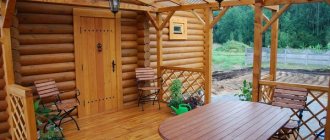The reliability of the entire roof depends on the correct installation work. The main structural elements are the rafter legs.
To provide stability, the elements are secured using side braces, a metal angle or staples. The beams are connected to each other at the ridge part of the floor; below, the rafters are attached to the mauerlat. The element can withstand the maximum load; lumber with a cross-section of 15 × 15 or 20 × 20 cm is used for its manufacture.
Attaching the rafters to the mauerlat: a little “materiel”
To begin with, we suggest looking at an illustration that shows two types of rafter systems:
The place where the rafter leg is attached to the base is called the support node. There are many such units in the system, but we will touch in detail on the lower fastenings of the frame with the rafters. The mauerlat and rafter legs are almost always made of wood, less often - of metal. It is more profitable and convenient to use wood, since this material is light in weight, easy to install and durable with proper installation and operation.
Types of support units by level of rigidity
Support nodes are the places where the rafters are attached to the roof elements:
In the case of iron connections, the nodes are fixed and rigid (welded or bolted). Wood is a softer and more dynamic material that can swell, dry out and deform. In this regard, experts recommend making support units with allowances for possible changes in the shape of the wood. Such nodes can have different degrees of mobility:
- Zero mobility unit
- rigid fastening with corners on both sides, in which the fastening of the rafters to the mauerlat remains motionless. - Connection of the first degree of mobility
- the beam can rotate in a circle. - The connection of the second degree of mobility
is circular rotation with displacement; the installation of special sliders or slides is provided. - Third degree movable joint
– possibility of horizontal, vertical and circular movement.
For any node, whether it is movable or not, at least two types of fixation should be used. For example, notched planks are additionally fixed from the inside using a support beam, and dynamic connections are strengthened with bolts and special steel angles.
Why single-pitched
The roof structure of 1 slope has the following advantages:
- When building on a pitched roof, you can use any type of roofing material. Because the angle of inclination can be very small, you can build an almost flat roof.
- The windage of this design is much less than that of a gable one. This option can be used in areas with strong winds.
- Ease of installation and operation. You can build it yourself.
- Light weight compared to other types of roofing.
- For a pitched roof, you can build slopes of several floors. This solution will add design to your home.
- Construction of a pitched roof is the most economical and does not require much time.
- In this design, water rolls off only on one side.
- The roof is suitable for any type of construction.
Like any other structure, a pitched roof has several disadvantages:
- With a small angle of inclination, the area of the attic space is minimal.
- Has a less attractive appearance. What can be corrected with the imagination of a designer.
About the types of fastening of rafters to the base
Let's talk about modern fasteners. For the strength and durability of the support units, a variety of metal fasteners are used: beam holders, equilateral, fastening, anchor, reinforced corners, plates, supports, profiles, connectors, anchors, etc. All these parts are made of high-quality metal. For dynamic units (types 1, 2 and 3), sliders, angles and perforated plates are used. For rigid fastening, stationary connectors, anchors and corners are used.
Such fasteners for the rafter system are most often used:
For self-assembly, perforated fasteners are more suitable than others, since they have many holes for self-tapping screws and bolts.
Rigid or flexible connections: what to choose
So, we noted that the support nodes connecting the Mauerlat to the boards can have different degrees of mobility: from “0” to “3”. Zero degree - these are rigid fastenings that exclude any changes in the position of the beams.
Rigid connections: when they are needed
The Mauerlat is installed when it is necessary to transfer the thrust load from the rafters to the load-bearing walls. This is done mainly in houses made of bricks, panels and blocks. In this case, they try to eliminate deformation and shrinkage of the roof in order to prevent changes in the load on the supporting walls. This is where the need arises for a fixed connection of the rafter system with the Mauerlat.
Fixed units secured with a notch
Many experts recommend making appropriate cuts at the point where the rafters are attached to the floor beams for greater strength and immobility of the connecting nodes. These cuts should fit tightly with the Mauerlat. Additionally, such units are strengthened with bolts, anchors and metal plates:
Or with long screws:
And one more important point: the size of the cut of the bar should not exceed 1/3 of its cross-section. Otherwise, the rafter system may lose its load-bearing capabilities:
Hard knots without notching rafters
The fastening method using a hemming block is used in layered rafter systems. The rafters are cut according to a template and beveled (to give the roof the desired slope) at the point of contact with the mauerlat. From the inside, such rafters are reinforced with support bars and reinforced with corners on both sides to the base frame:
Another option for a non-joint joint is a rigid fastening of the rafters, reinforced with overlay beams on both sides. Two boards at least a meter long border each rafter leg. One end of such supports is cut at an angle that corresponds to the slope of the roof slope (including rafters). The boards are fastened with a cut to the Mauerlat using long bolts and reinforced steel corners. The bars are attached to pre-marked places, first one at a time. Then the rafters themselves are mounted close to the overlays on one side, which are immediately reinforced with the same overlay on the other side. There is an option to install two beams at once, and then rafters, but this method is used less often, since it requires more accurate calculations.
Complex roofs
The more slopes and, accordingly, their intersections a roof has, the more complex the rafter system becomes. Thus, in multi-gable structures, part of the rafters rests not on the ridge (purlin), but on the valley beam. Such beams are called sloped valley rafters; they must be adjusted to the location and firmly fastened to prevent distortion of the structure as a whole.
For a hip roof, not only straight rafters are used (located at right angles to the ridge and mauerlat), but also diagonal rafters - along the lines of intersection of the slopes. Some of the straight rafters rest on them. A rigid fastening unit is also optimal here.
In hip roofs, most of the rafters are diagonal, and all straight ones (springs) rest on them. Due to this, precise fit of cuts and reinforced fastenings are especially important.
In arched roofs, instead of straight rafter beams, curved frames assembled from individual lamellas are used. The number of vertical posts with this design increases noticeably, since it is necessary to more evenly distribute the load over the curved composite element. The support of such arched rafters is only rigid, with a notch.
When do you need to make moving connections?
Here we come to dynamic support nodes - connections that can change their position. What is it for? Let's remember the physical properties of materials - many of them shrink or swell. First of all, this applies to buildings made of pure wood - timber, logs, etc. Natural wood necessarily shrinks, due to which your roof can not only be deformed, but also completely collapse. To avoid such fatal consequences, craftsmen recommend sliding fastenings of rafter legs with a mauerlat (or the upper crown of a log house).
A prerequisite when installing sliding units is to support the rafter frame on a strong ridge beam. Since the supporting lower nodes are dynamic, maximum rigidity should be achieved at the roof ridge. The upper edges of the rafters are sawed down for a tight connection between themselves and the ridge beam, connected and reinforced with crossbars, metal strips, plates and corners. It is better to connect the rafter element already fixed in the ridge to the crown of the log house.
What is a sliding mount?
The movable connection is made by installing sliding fasteners called “slides” or “sliders”. Such a unit provides a certain freedom for the rafter legs, which helps prevent deformation of the roofing system after the natural shrinkage of wooden buildings:
Here are the types of sliding supports:
Should I make a gash on the rafters if the house is made of timber: an alternative expert opinion
I still suggest cutting down, but not the rafters, but the top crown. Firstly, in this case, the risk of rafter bending is reduced, secondly, the “cold bridge” is reduced, thirdly, the tangential pressure on the mauerlat (top beam of the log house) is reduced, and fourthly, the insulation of the roof in the future is simplified. The disadvantage of this method is that when cutting down the upper crown of the beam, the height of the ridge decreases, therefore, if in the future it is planned to raise the height of the ceiling, one more crown should be provided. But! Such schemes are only suitable for houses made of wood, since in brick and concrete buildings the mauerlat must be intact in order to maintain its load-bearing qualities.
Determine the height to which you want to raise the wall
To ensure the found slope angle of the pitched roof, it is necessary to raise one of the walls higher. How much higher we will find out by remembering the formulas for calculating a right triangle. Using them we also find the length of the rafter legs.
How to calculate the parameters of a pitched roof
When calculating, do not forget that the length is obtained without taking into account overhangs, and they are needed to protect the walls of the house from precipitation. The minimum overhang is 20 cm. But with such a small protrusion beyond the building, the pitched roof looks short. Therefore, overhangs of at least 60 cm are usually made on one-story buildings. On two-story ones they can be up to 120 cm. In this case, the width of the overhang is determined based on aesthetic considerations - the roof should look harmonious.
Example of a drawing in ScratchUp
The easiest way to determine how much the roof needs to be extended is in design programs that allow you to draw the building to scale and “play” with the overhangs. Everything should be displayed in 3 dimensions (the most popular program is ScratchUp). Twist through different sizes of overhangs, decide which one looks better (if there is no project), and then order/make rafters.
How to properly attach rafters to beams?
In simple houses, mostly frame ones, the Mauerlat can be abolished. In this case, the rafters are attached to the floor beams. The most reliable option for assembling such a system is the preparation of roof trusses. Each truss consists of two rafter legs, a connecting crossbar and a bottom tie. For strength, the trusses are reinforced with central beams and struts:
The floor beams are laid in such a direction that the trusses intersect them perpendicularly in different planes. The tie performs the main load-bearing functions, is attached to the floor beams with anchors, through bolts, studs and reinforced with plates and metal corners.
It is possible to attach the rafter legs directly to the beam, which will additionally serve as a tightening. To create high-quality support units in such a system, two fastening methods are recommended:
- Connecting the rafters to the beam with a double tooth - cuts are made on the beam and the bevel of the rafter leg (two butt notches on each).
- Fastening with bolt and clamp. Through fastening may be provided, but if the boards have a large cross-section, notches are made and the parts are connected with long bolts.
Why do you need a Mauerlat?
The rafter system absorbs the load from external forces and transfers it to the walls through the support beam - the Mauerlat. Its functions are to create a flat plane for attaching rafters and distribute evenly point forces on supporting structures.
As a rule, in private construction the mauerlat is made from softwood lumber - timber or boards. The size of the section and the method of attachment to the walls depends on the type of rafter system:
- With layered rafters, large bursting forces are transferred to the walls. The cross-section of the Mauerlat is powerful enough - 150x150-200x200 mm - to ensure load absorption. It is attached to the walls as firmly as possible.
- In hanging systems, the rafter legs are rigidly connected to a horizontal tie, forming a geometrically stable truss. Only vertical load is transferred to the walls, so the Mauerlat acts as a support pad. In this case, timber or boards are laid either on the entire surface of the walls, or in sections for each truss.
Lumber for the Mauerlat must be at least grade 2, dried to a moisture content of no more than 15%, and treated with antiseptics and fire retardants. To prevent wood from rotting, waterproofing is installed when laying on brick or concrete walls.
Joint location of the support beam
Attaching the rafters to the mauerlat: step-by-step description
As an example, we will describe the process of rigidly attaching rafter connections to the Mauerlat on a simple gable roof.
I. Preparing the mauerlat and rafters for work
At this stage, it is necessary to cut out the rafter legs of a given length and mark their step on the base. The optimal step length of the rafter legs is 60-200 cm. You should also accurately determine the angle of inclination of the rafters.
Master class on installing the Mauerlat:
II. Creating a gash
We make a gash on each rafter leg for a tight connection with the base. To increase strength, you can provide an additional notch on the frame or rafter and install a thrust beam under each rafter leg.
III. Installing rafters on the mauerlat
The rafters must be laid carefully so as not to damage other elements of the building (windows, walls, etc.). We place the boards with a cut on the beams and rest them on the ridge beam. First, we install the outer rafter legs, between which you need to stretch a thread to align all the other rafters.
IV. Fastening each rafter to the mauerlat
Now that all the trusses are in place, you need to firmly secure the support units. For this we use several of the mounts suggested above:
- Nails
+ steel angles along the left and right sides of the joints between the board and the base. - Through bolts or studs
+ support beam for rafters. - Anchors or bolts
+ angles or steel plates, etc.
Two overhead boards on both sides of the rafter leg, installed on pre-marked places on the mauerlat, will help to strengthen the fastening. You can also use wire fastening as a strength enhancer for connections. To do this, you need to prepare a steel wire twist of 2-3 wires. Its length should be enough to wrap around the rafter leg at the junction with the Mauerlat and secure the ends of the twist to a metal crutch. As a crutch, you can take a long steel bolt, which is mounted into the wall 30-40 cm below the Mauerlat, strictly under the support unit.
We will also consider one of the old-fashioned methods - fastening with staples:
And finally, we suggest you watch the video:
Classification of connecting nodes
The roof frame consists of a number of elements securely fastened together. But the main operational load is borne by the rafters, so the functional characteristics of the roof and the safety of the entire structure depend on the strength of their fastening to the Mauerlat and their connection to each other.
Rafter systems, hanging and layered, transfer the load from their own weight, the weight of the roofing pie and atmospheric influences to load-bearing walls and other structures. The lower ends of the rafters rest on a support beam or mauerlat, the upper ends are fastened in pairs directly to each other or mounted to the ridge girder. In addition, for structural rigidity, additional supports, crossbars, struts and other elements are used. If it is necessary to increase the length of the rafters, the rafter legs are extended. In general, rafter connection nodes can be divided into several main groups
:
- connection unit with the “foundation” of the roof”;
- ridge connection unit;
- fastening unit for additional elements of the rafter system;
- joining rafters when building up.
All types of rafter connections require the use of certain fasteners.
Extension of rafters
Connecting the rafters together along the length allows you to make a rafter leg of the required dimensions from the available lumber. Most often, splicing is performed using the following joining methods
:
- end-to-end;
- overlap;
- method of oblique cutting;
- in three boards;
- with support on the purlin.
Butt mount
. To splice, the abutting ends must be cut strictly at an angle of 90°. After tightly combining the resulting ends, a wooden plate or a metal fastening element (plate with teeth) is mounted on the rafters at the joint. Board overlays are installed on both sides and nailed in a checkerboard pattern with nails of the appropriate length, or fastened with self-tapping screws.
Oblique cut method
. The ends are trimmed at an angle of 45°. The cut ends are joined, after which a through hole for bolt fastening is drilled in the middle. The bars are tightened with a bolt with a diameter of 12 or 14 mm with a wide washer.
Overlap fastening
. The wooden elements are laid with an overlap and sewn together along the entire length with nails, which should be staggered. In some cases, studs with nuts and washers can be used. This connection of rafters along the length does not require precise cutting of the ends.
A long rafter leg can be made using three boards and spacers. In this case, one of the boards is laid between the other two with an overlap of at least a meter and fastened with nails in a checkerboard pattern. Then, wooden spacers equal in thickness to the middle board are inserted and nailed into the empty space between the outer boards to ensure rigidity of the structure.
The connection of rafters along the length with support on the intermediate purlin is carried out in the case when all rafter legs are built up at the same distance from the roof overhang. The horizontal purlin is mounted on racks that rest on the internal load-bearing wall or columns. In the case where the splice is located on the purlin, it becomes possible to provide the necessary rigidity of the long rafter leg. Both parts of the rafters are connected to each other with staples or other elements, and additionally secured to the purlin with nails.
The extended rafter leg must have the same rigidity and strength along its entire length, otherwise the roof will deform during operation.
What is the secret of the quality of the rafter system: three main rules of the master
- High-quality lumber is half the battle on the path to successful construction. The mauerlat and rafters should not have cracks, wormholes or knots.
- The accuracy of measurements, cuts and uniformity of the position of the fasteners is an equally important point. If all the rafter legs are the same length and cross-section, then it is better to prepare a template for making cuts and notches.
- Gaps on the Mauerlat – loss of the load-bearing functions of the base by 50% or more. The percentage of strength reduction depends on the depth of the notches.
When the rafter system is ready, it’s time to install the sheathing, insulation and roofing material. But this is another interesting topic, which we will definitely talk about in the next article. In the meantime, we wish you good materials, easy work and good helpers!
